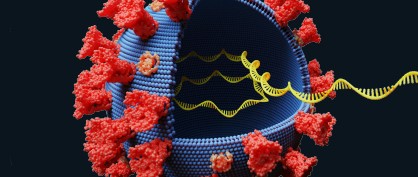Gene Theft: Viruses Make Hybrid Proteins
By Dora Fatula
Researchers have found that some viruses commit theft by capturing genetic signals from their hosts and adding them to their own genetic code.
This finding was first reported in Cell by a cross-disciplinary collaboration of scientists at the Global Health and Emerging Pathogens Institute at Icahn School of Medicine at Mount Sinai in New York and the MRC-University of Glasgow Centre for Virus Research in the UK.
What Are sNSVs?
The teams of virologists examined a large group of segmented negative-strand RNA viruses (sNSVs) that are known to cause serious diseases in humans, domesticated animals, and plants, including influenza, Hanta, and Lassa viruses.
Viruses do not form their own proteins; they give instructions to the hosts’ cell machinery to make proteins. In a process called "cap-snatching," the virus cuts the end from a piece of the cell's own messenger RNA (mRNA) and adds to it one of the viral genes to produce a hybrid message.
How Viruses Work
The hybrid mRNA lets the sNSVs send messages with extra, host-derived start codons, a process called "start snatching." By “stealing” genetic signals from their hosts, new proteins, the researchers call “UFO” (Upstream Frankenstein Open reading frame), are encoded from the combination of host and viral sequences. These hybrid gene products are visible to the immune system and may affect virulence.
"To understand how a pathogen antagonizes the host and establishes infection, we need to have a clear understanding of what proteins a pathogen encodes, how they function, and the manner in which they contribute to virulence," said Ivan Marazzi, PhD, Associate Professor of Microbiology at Icahn School of Medicine and corresponding author on the study.
The Roles of Unexpected Genes
"For decades we thought that by the time the body encounters the signal to start translating that message into protein (a 'start codon') it is reading a message provided to it solely by the virus. Our work shows that the host sequence is not silent," said Dr. Marazzi.
These UFO proteins may change the course of an infection and could also be useful for creating vaccines. Further studies are needed to understand these new proteins and the implications of their pervasive expression by RNA viruses that can cause epidemics and pandemics.
"This work implies that a huge number of viral species can make previously unsuspected genes," according to Ed Hutchinson, PhD, corresponding author and a research fellow at MRC-University of Glasgow Centre for Virus Research.
The next part of their work is to understand the distinct roles the unexpected genes play. "Now we know they exist, we can study them and use the knowledge to help disease eradication," said Dr. Marazzi. "A large global effort is required to stop viral epidemics and pandemics, and these new insights may lead to identifying novel ways to stop infection."
Discussion Questions
- Are viruses alive?
- How do viruses reproduce?
- How do viruses cause illness?
Vocabulary
- Pandemic
- Infection
- Codon



